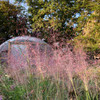

WELCOME BACK!
Our earliest available ship date is the week of April 28th.
Please note your preferred ship date/week in the "Order Comments" section at checkout.
See the "Shipping" page under "Company Information" for our default ship dates based on hardiness zone.
We are unable to ship to any US Territories, AK, AZ, CA, CO, HI, ID, MT, NM, NV, OR, UT, WA, or WY
Also known as "Pink hair grass," this very showy fall grass forms regular mounds of fine leaves topped by airy pink to pink-red seed heads at the end of the season.
This native grass has some great qualities – it’s highly ornamental and adaptable, as it is tolerant of drought, heat, humidity, air pollution, salinity, black walnut trees, and poor, dry soils. It doesn’t spread, instead staying in tidy clumps, and provides a good habitat for wildlife and nesting material and seeds for smaller birds.
Desirable for public plantings such as in small islands between road and sidewalks, larger road islands, highways, as well as flower borders, natural plantings, prairie style plantings, naturalization, cottage gardens or any private gardens. It looks the best in groups or mass plantings, and it's good to combine it with other plants, because it stays "invisible“ for most of the season and creates only small, low-growing loose clumps that are of little interest.
Add any spring flowers that grow from bulbs - tulips, crocuses, daffodils, or early flowering perennials like Euphorbia polychroma, Iris x germanica, Paeonia.
Stunning fall combinations are with Amsonia hubrichtii, fall Asters, Helianthus angusifolius ‘Low Down, Sedum telephium (’Autumn Joy and other cultivars), other grasses like Calamagrostis x acutiflora ‘Karl Foerster‘, Pennisetum alopecuroides or autumn flowering bulb of Colchicum autumnale.
Nice perennial combinations could be with the already-dry seed heads of Echinacea pallida, Echinacea purpurea, Liatris aspera, Monarda bradburiana, Monarda fistulosa, Monarda pucntata, Rudbeckia fulgida or with the big leaves of Silphium laciniatum.
Picture copyright : US Perennials
Blooming Time: September to November
Size: mounds 4’ tall and wide (3’ without flowers)
USDA Zones: 5 to 9
Culture: from full sun to half shade. Adaptable to many different soils, tolerates temporary flooding, acid and alkaline pH, excessive wind and moderate salinity. Does best in full sun and drained soils with some gravel or rock material, as well as poor soils. It will not grow in waterlogged soil and winter wetness.
Moisture Needs: dry, medium-dry, medium
Origin: native grass to Eastern/Central United States, from Massachusetts to Florida, open sandy or rocky woodlands, pine barrens, prairies, sandy dunes, savannas with acidic or calcareous sandy or gravelly soil.
Deer/Rabbit Resistant: yes / yes
Attracts Butterflies or Pollinators: offers safe habitat for insects and wildlife
Attracts Hummingbirds: no, but small birds feed on seeds; provides nesting material
Pot Size: 3.5" x 4" perennial pot (1.22 pt/580 ml)
Also known as "Pink hair grass," this very showy fall grass forms regular mounds of fine leaves topped by airy pink to pink-red seed heads at the end of the season.
This native grass has some great qualities – it’s highly ornamental and adaptable, as it is tolerant of drought, heat, humidity, air pollution, salinity, black walnut trees, and poor, dry soils. It doesn’t spread, instead staying in tidy clumps, and provides a good habitat for wildlife and nesting material and seeds for smaller birds.
Desirable for public plantings such as in small islands between road and sidewalks, larger road islands, highways, as well as flower borders, natural plantings, prairie style plantings, naturalization, cottage gardens or any private gardens. It looks the best in groups or mass plantings, and it's good to combine it with other plants, because it stays "invisible“ for most of the season and creates only small, low-growing loose clumps that are of little interest.
Add any spring flowers that grow from bulbs - tulips, crocuses, daffodils, or early flowering perennials like Euphorbia polychroma, Iris x germanica, Paeonia.
Stunning fall combinations are with Amsonia hubrichtii, fall Asters, Helianthus angusifolius ‘Low Down, Sedum telephium (’Autumn Joy and other cultivars), other grasses like Calamagrostis x acutiflora ‘Karl Foerster‘, Pennisetum alopecuroides or autumn flowering bulb of Colchicum autumnale.
Nice perennial combinations could be with the already-dry seed heads of Echinacea pallida, Echinacea purpurea, Liatris aspera, Monarda bradburiana, Monarda fistulosa, Monarda pucntata, Rudbeckia fulgida or with the big leaves of Silphium laciniatum.
Picture copyright : US Perennials
Blooming Time: September to November
Size: mounds 4’ tall and wide (3’ without flowers)
USDA Zones: 5 to 9
Culture: from full sun to half shade. Adaptable to many different soils, tolerates temporary flooding, acid and alkaline pH, excessive wind and moderate salinity. Does best in full sun and drained soils with some gravel or rock material, as well as poor soils. It will not grow in waterlogged soil and winter wetness.
Moisture Needs: dry, medium-dry, medium
Origin: native grass to Eastern/Central United States, from Massachusetts to Florida, open sandy or rocky woodlands, pine barrens, prairies, sandy dunes, savannas with acidic or calcareous sandy or gravelly soil.
Deer/Rabbit Resistant: yes / yes
Attracts Butterflies or Pollinators: offers safe habitat for insects and wildlife
Attracts Hummingbirds: no, but small birds feed on seeds; provides nesting material
Pot Size: 3.5" x 4" perennial pot (1.22 pt/580 ml)
